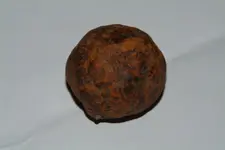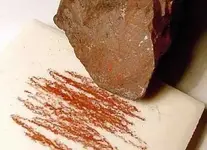I'm pleased to be of assistance, Caliera. Welcome to TreasureNet and the What-Is-It forum.
In the photo, your iron ball appears to have very thick rust-&-dirt encrustation, which affects your diameter-versus-weight calculation of the ball. If the thick crust was removed, its reduced diameter will be appropriate for its weight.
You said your rust-encrusted ball is 45 millimeters in diameter, and weighs 200 grams. A clean cast-iron ball which is 37mm in diameter weighs approximately 195 grams (which is just below your ball's weight).
In my nearly 40 years of excavating cannonballs, I've encountered an unusual variety of iron corrosion known as "Graphitization." It happens in what we relic-diggers call "wet ground." It causes the buried iron to develop a thick rust-&-dirt concretion which looks like smooth mud (as we see on your ball), instead of the usual bumpy concretion we see on iron relics dug from "dry ground." The Graphitization process chemically leaches iron molecules out of the iron's surface into the surrounding dirt. Those leached-out iron molecules then petrify the dirt around the iron, causing a thick "cocoon" to form around the iron relic. When that cocoon is removed, the iron relic weighs noticeably less than it ought to for its size, due to the loss of a significant amount of iron molecules from within it.
Important note:
Relic-diggers often unknowingly break the cocoon off of a Graphitized iron relic as the dig it out of the ground. When that happens, the iron relic comes out of the dig-hole WITHOUT the usual bumpy rust-brown color, instead looking an almost rust-less dark greyish-black. But in your case, the Graphitization cocoon didn't get broken off.
Please pardon the long-winded technical explanation of what has happened to your long-buried iron ball. I hope it wasn't too complicated to understand clearly.
Now, about whether your iron ball is a cannonball or not:
I am taking into consideration an assumption that you dug it in South Wales, where you live. After the rust-cocoon on your Graphitized iron ball is removed, the ball's size is "very near" the correct diameter to be a Canister-ball, which is a type of antipersonnel ammo for cannons. Canister is the equivalent of buckshot for cannons. It was basicly a simple "tin can" filled with iron balls. In most cases, the Canister-balls' size varied from just above 1 inch to just above 2 inches, depending on the cannon's caliber.
For Canister-ball diameter & weigh data, see the third chart at:
Cannon bore, shot, and shell diameters for smoothbore guns
But, Canister ammo did not exist until the early-1800s. I am unaware of any artillery combat during that century in South Wales.
As you'll see from the charts in the link given above, the smallest caliber of Military cannons was the 1-pounder cannon. It was so named because its cannonball weighed one pound. Those 1-pounder caliber cannonballs were 1.95-inches in diameter, which about 12mm smaller than your ball. So, your ball, in the strict-definition sense, is not a "cannonball" (which means, a single ball which is just slightly smaller than the cannon's bore diameter).
There is a chance it is a ball from an earlier form of cannon ammunition which was called Quilted-Grapeshot. That was a group of small-ish iron balls held together by a canvas bag on top of a thick iron plate. (Without the iron plate under the balls to push them out of the cannon upon firing, some balls tended to remain in the cannon's bore.)
So the question becomes, was any quilted-Grapeshot ever used in artillery combat in South Wales? I do not know the answer to that question.
Also, there have been multi-millions of iron balls which were not manufactured to be artillery balls. Some examples are rock-crusher and coal-pulverizer balls, which quite frequently turn up in areas where mining, refining, and stonemilling has occurred.
So, after all this writing (and for you, reading), my answer to your question "Is it a cannonball?" has to be "Maybe." Unfortunately, I do not have historical data on artillery used in South Wales, nor on the sizes of European Quilted-Grapeshot balls from the 1600s/1700s. And of course, if there has been mining/refining/stonemilling in South Wales, it could be a crusher/pulverizer ball from those industries.
I hope the long reading has been at least somewhat entertaining, although probably also disappointing.
 . I thought at first it was a small cannonball but it seems to be to light. It measures 45 millimeters diameter and is 200 gms in weight. It has a smooth dimply surface and a rusty brown appearance. I stumbled across this great website whilst trying to research this and am hoping that maybe the cannonball guy might know. Any help would be greatly appreciated
. I thought at first it was a small cannonball but it seems to be to light. It measures 45 millimeters diameter and is 200 gms in weight. It has a smooth dimply surface and a rusty brown appearance. I stumbled across this great website whilst trying to research this and am hoping that maybe the cannonball guy might know. Any help would be greatly appreciated 
 . I thought at first it was a small cannonball but it seems to be to light. It measures 45 millimeters diameter and is 200 gms in weight. It has a smooth dimply surface and a rusty brown appearance. I stumbled across this great website whilst trying to research this and am hoping that maybe the cannonball guy might know. Any help would be greatly appreciated
. I thought at first it was a small cannonball but it seems to be to light. It measures 45 millimeters diameter and is 200 gms in weight. It has a smooth dimply surface and a rusty brown appearance. I stumbled across this great website whilst trying to research this and am hoping that maybe the cannonball guy might know. Any help would be greatly appreciated 




